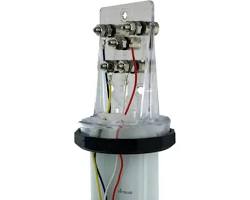Cathodic Test Station

 Cathodic test point, also called cathodic protection (CP) test station, is a designated location within a CP system used to monitor and evaluate the system's performance in preventing corrosion on metal structures, such as pipelines, storage tanks, or other buried or submerged metallic assets. Typically installed at strategic intervals along the protected structure, test points consist of access points, such as test stations or junction boxes, where technicians can connect instruments to measure electrical parameters like potential (voltage) differences between the structure and a reference electrode. These measurements help determine whether the cathodic protection system, whether galvanic (using sacrificial anodes) or impressed current, is effectively maintaining the structure at a sufficiently negative potential to inhibit corrosion.
Cathodic test point, also called cathodic protection (CP) test station, is a designated location within a CP system used to monitor and evaluate the system's performance in preventing corrosion on metal structures, such as pipelines, storage tanks, or other buried or submerged metallic assets. Typically installed at strategic intervals along the protected structure, test points consist of access points, such as test stations or junction boxes, where technicians can connect instruments to measure electrical parameters like potential (voltage) differences between the structure and a reference electrode. These measurements help determine whether the cathodic protection system, whether galvanic (using sacrificial anodes) or impressed current, is effectively maintaining the structure at a sufficiently negative potential to inhibit corrosion.By providing critical data on the system's functionality, test points enable operators to verify compliance with corrosion protection standards, identify areas requiring maintenance, and ensure the longevity of the infrastructure. Test points can range from simple enclosures with cable termination points to more advanced "smart" stations equipped with sensors and data acquisition systems for remote, real-time monitoring. Regular testing at these points is essential for optimizing system performance and preventing costly structural failures due to corrosion.

